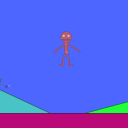Motion
From Algodoo
Motion
| Language: | English |
|---|---|
| Description: | Motion is a fundamental concept in science. This lesson explores different causes of motion, such as pull, push, drop (gravity), and also introduces the term force. |
| Target: | Key Stage 1, Key Stage 2 |
| Category: | Demonstration, Exercise, Laboratory |
| Discipline: | Static forces, Dynamic forces, Gravity, Motion |
| Learning objectives: |
Knowing different ways of setting an object into motion. Knowing a cause of motion (push, pull, drop, slide) in terms of influence of a force. Knowing about the relation between speed, distance and time. |
| In class: | Discuss what causes an object to move. Let the students suggest different ways of setting an object into motion and list them on the whiteboard. For example pushing, pulling, throwing, dropping, sliding, adding a motor.
Discuss that the cause of motion is called force. Discuss how the size of the force influences the motion. Discuss relation between speed, distance and time. Discuss how this can be visualized and explored in Algodoo. Let the students create scenes in Algodoo using the suggestions you came up with together or let them use their own ideas. Help the students make decisions and ask guiding questions. Encourage the students to follow the procedure Create – Predict – Interact – Evaluate. Allow the students to follow-up and share their experiences in class after the simulation. |
Create a scene
Make a prediction
Run interact
Evaluate
How long do they roll?
Adding a motor to the hinge and visualizing velocity arrows may help the analysis.




